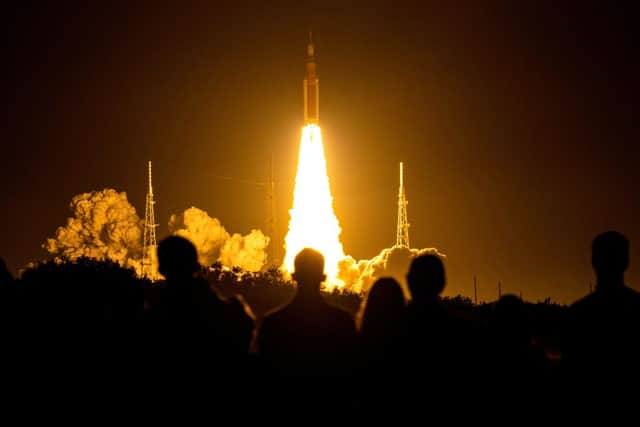Artemis moon mission: NASA launches Artemis I, most powerful rocket launch and mission explained - name meaning
and live on Freeview channel 276
NASA’s Artemis spacecraft from NASA has arrived at the Moon, flying 80 miles above the lunar surface. It has since entered a larger orbit.
Following a series of failed efforts earlier this year, NASA successfully launched its Artemis lunar mission last week, testing the agency's Space Launch System (SLS) rocket, Orion spacecraft and ground systems.
Advertisement
Hide AdAdvertisement
Hide AdThe SLS lifted off from its launch location in Florida at 6.47am GMT (1.47am local time), marking a watershed moment for NASA.
The 322ft (98m) tall SLS rocket, the world's most powerful rocket to date, is being used to launch the Orion spacecraft into lunar orbit, fueled by the Airbus-built European Service Module (ESM).
Here is everything you need to know about it.
What is the Artemis I mission?
The unmanned voyage around the moon - the flight is transporting mannequins rather than people - is the next step in re-establishing a human presence on the moon, and will pave the way for a crewed Artemis flight test and eventual human lunar exploration.
The rocket's upper stage is designed to lift the Orion spacecraft out of Earth’s orbit, on course for a 25-day voyage that will put it to within 60 miles (97 km) of the lunar surface, before sailing 40,000 miles (64,374 km) beyond the moon and returning to Earth.
Advertisement
Hide AdAdvertisement
Hide AdThe whole process is expected to take just over three weeks, with the capsule scheduled to land back on Earth on Sunday 11 December.
The spacecraft is also carrying a cargo of ten small science satellites known as CubeSats, one of which will map the amount of ice deposits on the moon's south pole, where Artemis hopes to someday land astronauts.


Why was the launch delayed?
The initial planned Artemis I launch failed due to technical issues at the end of August, and a second attempt at the beginning of September was impeded by a fuel leak. A third attempt, scheduled for late September, was pushed back due to Tropical Storm Ian.
There were worries that the mission could have been delayed further, after Hurricane Nicole caused minor damage to the rocket and spacecraft earlier this week.
Advertisement
Hide AdAdvertisement
Hide AdBut mission officials met on Monday (14 November) to discuss the rocket and spacecraft's flight readiness, determining that there was little probability that additional material tearing off would endanger the flight. They then gave the launch “go” to proceed.
Even then, the eventual launch was not without issue, with a three-man “red team” dispatched to the launch pad to tighten bolts on a loose connection discovered as the source of a possibly flight-thwarting fuel leak in the last hours of the countdown.
Specially trained to enter the dangerous "blast zone" surrounding a fully fuelled rocket, the three engineers were afterwards lauded as heroes who may have saved the mission.
When will the first crewed Artemis launch take place?
Artemis I’s unmanned journey around the moon – the flight is transporting mannequins fitted with sensors to monitor radiation levels and other stresses that astronauts face – is the next stage in re-establishing a human presence on the moon, and will pave the way for a crewed Artemis flight test and eventual human lunar exploration.
Advertisement
Hide AdAdvertisement
Hide AdIf the mission is successful, a crewed Artemis II voyage around the moon and back might occur as early as 2024, followed by the programme's first lunar landing of astronauts, one of whom will be a woman, with Artemis III in a few years. NASA hopes to return astronauts to the lunar surface by 2025, for the first time in more than 50 years.
The new moon programme has attracted commercial partners like Elon Musk's SpaceX, and the European, Canadian and Japanese space agencies, who hope to eventually create a long-term lunar outpost as a stepping stone to even more ambitious manned missions to Mars.
It also represents a significant shift in NASA's post-Apollo human spaceflight programme, which had previously been concentrated on low-Earth orbit with space shuttles and the International Space Station.
What does ‘Artemis’ mean?
The Artemis mission is named after the ancient Greek goddess of hunting, and the twin sister of Apollo, who gave his name to the missions that first put man on the moon in the late 60s and early 70s.
Comment Guidelines
National World encourages reader discussion on our stories. User feedback, insights and back-and-forth exchanges add a rich layer of context to reporting. Please review our Community Guidelines before commenting.
